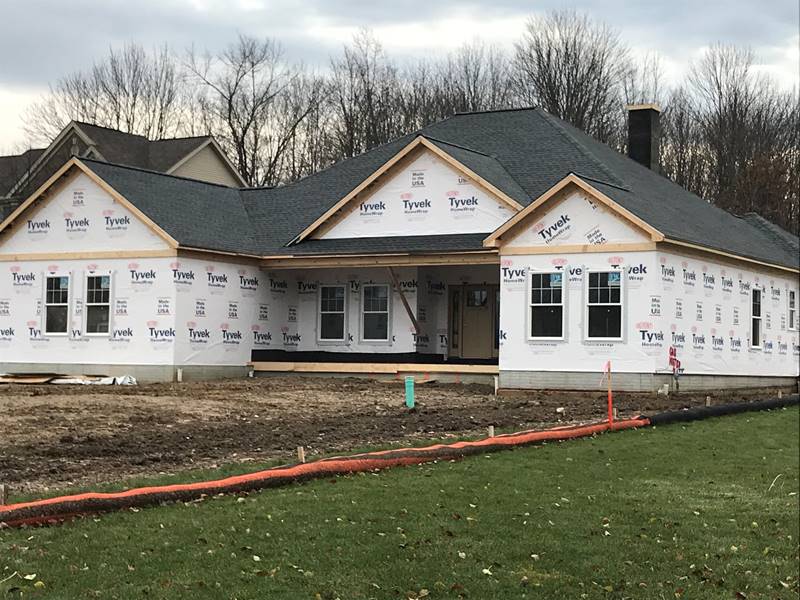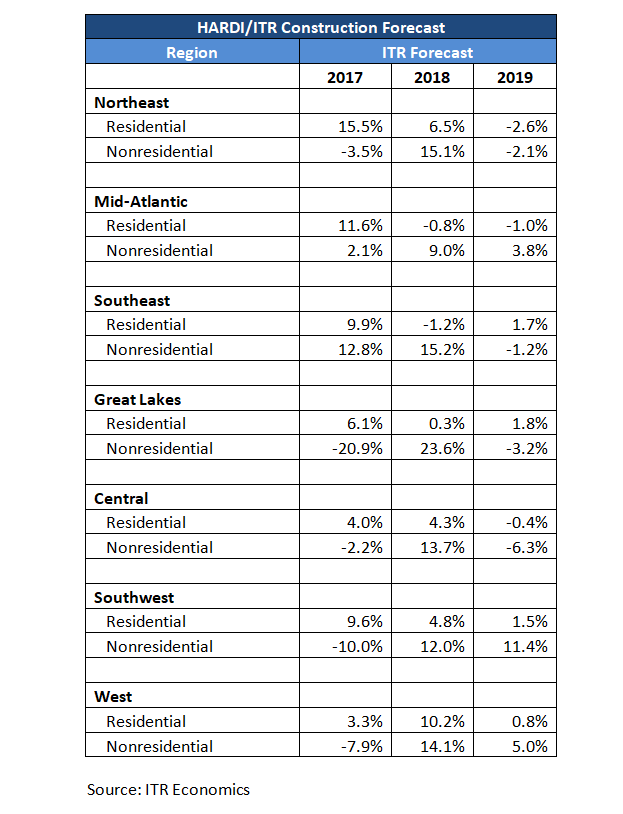Economy

HARDI/ITR Quarterly Forecast July 2017, Part 2
Written by Sandy Williams
July 25, 2017
A mild recession will impact residential and nonresidential construction in 2019, predicts the HARDI/ITR July quarterly report.
Steel Market Update is a member of an association connected to the construction industry called the Heating, Air-conditioning & Refrigeration Distributors International. HARDI and ITR Economics, an economic forecasting company, work together to gather economic data to provide a forecast to the HARDI members in the United States and Canada. The information shared in our newsletter is only part of a much larger package seen by participating HARDI member companies.
ITR looks at data using a 3-month and 12-month moving average to determine where business is within the growth cycle. Our last issue covered the general economic overview, as well as construction forecasts for the Northeast, Mid-Atlantic, and Southeastern Region based on data as of the end of May 2017. Today, we will cover the Great Lakes, Central, Southwestern and Western regions.
Great Lakes
Housing permit growth in the Great Lakes region in the past year was primarily driven by single-family permits, which expanded at double-digit rates in Indiana, Michigan and Ohio, offsetting a decline in multi-family authorizations. In the 12 months through May, housing permits grew 8.3 percent year-over-year to 69,500. Home prices grew across the region, but slowed in Ohio, Indiana and Pennsylvania. West Virginia exceeded the year-ago level by only 0.4 percent. ITR expects housing permit growth to remain on track at 6.1 percent expansion for 2017 and then slow to 0.3 percent in 2018 and 1.8 percent in 2019.
Nonresidential spending plummeted in the 12 months through May, unable to match robust growth in 2016, said ITR. The decline will continue through late 2017 for a total decline of 20.9 percent for the year. Construction is expected to pick up in 2018, rising 23.6 percent before declining again through most of 2019 and ending the year -3.2 percent.
Central
Central region housing permit growth slowed in recent months necessitating a downward revision to the ITR forecast for 2017. The region is heavily dependent on the agriculture industry, which has seen commodity prices moving downward. That, in turn, is expected to slow the rate of growth for housing permits. Home prices rose in every state of the region except North Dakota, which is still negatively impacted by oil prices and headwinds to the energy industry. Colorado prices posted the most growth due to a 1.7 percent surge in population during the last 12 months. ITR forecasts 4 percent permit growth for 2017, 4.3 percent in 2018 and -0.4 percent for 2019.
Nonresidential construction in the region transitioned to recession since the last ITR quarterly report. Although most states are above year-ago levels, nonresidential construction slowed overall in the region. Colorado, North Dakota and Wyoming (down 33 percent, 64 percent and 55.6 percent, respectively) are primarily responsible for the decline and are expected to remain in a downward trend for the near term. Best opportunities for HARDI member business will be in Illinois and South Dakota, which are experiencing double-digit acceleration. Construction is expected to be relatively flat into early 2018 before starting an upward trend. In 2019, construction in the region will again fall into recession as the economy experiences a mild downturn. The forecast is -2.2 percent in 2017, 13.7 percent in 2018, and -6.3 percent in 2019.
Southwest
Single-family housing permit authorization is outpacing multi-family housing in the Southwest. The region gained 0.1 percent year-over-year in the 12 months through May and the multi-family weakness resulted in ITR downgrading their forecast for the region. Although Texas, which leads the Southeast in permit authorizations, is down 0.6 percent for the period, its quarterly growth rate was up 10.5 percent, indicating acceleration for the state. Oklahoma is the weakest area in the region, down 4.6 percent. Home prices in Texas rose at the fastest pace in the Southwest as an influx of population tightened supply. ITR expects housing permits to rise 9.6 percent in 2017, 4.8 percent in 2018 and 1.5 percent in 2019.
Nonresidential construction spending fell 8.3 percent year-over-year to $34.1 billion in the 12 months through May. Construction declines are expected to persist through 2017 before acceleration takes hold in 2018. By sector, government construction was up 43.0 percent in May year-over-year and medical construction increased by 15.3 percent. Commercial and retail are driving the decline in the region, said ITR. Although population is growing in Texas, nonresidential construction is not keeping pace and was down 15.1 percent at the end of May and heading lower. ITR expects nonresidential construction in 2017 to be 10 percent below 2016 levels. Construction will pick up in 2018 by 12 percent and 11.4 percent in 2019.
West
Housing permit authorizations in the West totaled 260,400 units, an increase of 5.1 percent year-over-year in the 12 months through May. Permits are expected to rise into 2018 before decelerating in mid-2019. A decline in California housing permits is dragging down the region, but multi-family permits are trending higher and should in combination with expanding single-family permits drive growth for the region. Arizona, Washington, Nevada, and Utah are improving on a 3-month moving average basis. Alaska, Oregon, and Hawaii permits declined during the last reporting period. Home prices in the region were above year-ago levels. ITR expects a 3.3 percent increase in housing permits for 2017, 10.2 percent in 2018 and 0.8 percent in 2019.
Nonresidential construction spending is on a downward trend in most of the West. Alaska, Idaho and Oregon are the only states that were accelerating year-over-year since the last report. Best bets for construction opportunities in the region are in government and education construction. ITR forecasts a 7.9 percent year-over-year decline in 2017, followed by growth in 2018 to 14.1 percent. A mild contraction is expected in 2019, reducing growth for the year to 5 percent.

Sandy Williams
Read more from Sandy WilliamsLatest in Economy

Fed Beige Book: Economy improves, but manufacturing weak
While general economic conditions across the US improved slightly over the last six weeks, activity in the manufacturing sector was weak, according to the Fed’s latest Beige Book report.

SMU Community Chat: Simonson with the latest on construction
A lot of economists were predicting a recession last year. Ken Simonson, chief economist for The Associated General Contractors of America (AGC), wasn’t one of them.

Housing starts slip to seven-month low in March
Following a strong February, US housing starts eased through March to a seven-month low, according to the most recent data from the US Census Bureau.

Manufacturing activity in New York state continues to soften
New York state saw a continued decline in manufacturing activity in April, according to the latest Empire State Manufacturing Survey from the Federal Reserve Bank of New York

Worldsteel projects steel demand to grow 1.7% this year
Global steel demand will reach roughly 1.793 million metric tons (1.976 million short tons) this year, an increase of 1.7% over 2023, the World Steel Association (worldsteel) said in its updated Short Range Outlook report. The gain will come after a 0.5% contraction in steel demand in 2023. Demand is forecasted to increase another 1.2% […]

